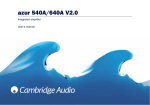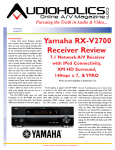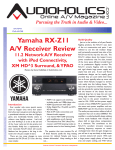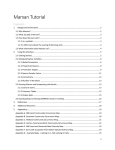Download Yamaha RX-A800BL Specifications
Transcript
review 12 . 1 4 . 1 0 Yamaha RX-A3000 Aventage 11.2 Networking A/V Receiver Review Review by Clint DeBoer & Gene DellaSala www.audioholics.coM of Audioholics.com Introduction AV receivers are constantly changing, constantly leap-frogging one another in features and capabilities. This year Yamaha announced its Aventage (RX-A) line and, in the process, jumped over a lot of the competition. And not a little jump, more like an Olympic gold medal long jump. Much of that jump is simply in the way of value - I mean the Aventage line in general has build quality and features that seem like it should cost a lot more than it does. The RX-A3000 takes that to the nth degree. There are five receivers in the Aventage lineup and the RX-A3000 is the flagship. The line is a simplified high-end run at the AV receiver concept. As such, there is a very defined delineation between models, but a few specific break points define some key places where some users will seek to spend a little more and up the ante on the return for their investment. Let’s take a quick look (see chart on page 2). As we see it, there is a definite line in the sand drawn after the RX-A1000 which adds a significant amount of power, HQV Vida processing and Zone 2/3 video capabilities. If you want the high-end of what Yamaha is now offering, you’re going to want to get into the RX-A2000 or RX-A3000. Take a look down the line, however, and it’s remarkable what the first three of the line manage to cram in at much lower price points. Economy of scale has done much to bring down the price for features you would simply not have dreamed of just a few years ago. HDMI Standby-through mode in a $600 receiver with a motion GUI interface and 12V trigger outputs? 2011 is going to be a good year for upgraders. Now for a trip back through memory lane. Back in 2008 Yamaha released its top of the line RX-Z7 AV receiver. It had 7 channels of amplification with 140 watts each. All manner of video upscaling (analogue and digital) was included and it had a whopping 5 HDMI inputs and even two paralleled outputs. For room correction, Yamaha pulled out the stops and debuted a new proprietary YPAO-based multi point room calibration system. For multi-room applications there was support for 4 Zones of audio (including a dedicated digital audio output for Zone 4) and networking features to stream online music and even allow the receiver to be controlled by an iPod Touch or iPhone. It weighed just over 40 pounds and cost $2700. It was pretty impressive to say the least. Then, two years later, Yamaha released the RX-A3000 Aventage receiver. It too has 7 channels of 140Watts each, the same analogue and digital upconversion. But it has 8 HDMI inputs and 2 outputs, all 3D compatible and supporting the latest features like Audio Return Channel. It also has even more impressive features, like the ability to bypass HDMI while in standby, so you can use your TV without having to turn on the receiver. It has close to the same advanced multi-zone YPAO room correction system and network features and the 4 Zones of audio. It adds another component video input, bringing the total to 4 - which is more than enough in our opinion, especially given the decline and phase-out of analogue outputs in favor of HDMI. It does remove one digital audio input and output. It also removed the two switched outlets on the back. But here’s the kicker. It’s nearly as hefty as the RX-Z7 and costs just $1700. Now we’re not going to say that the amplifier section is exactly the same as the RX-Z7, but given the feature set, weight and $800 cost savings, Yamaha’s RX-A3000 www.audioholics.coM RX-A3000 2 RX-A2000 RX-A3000 Aventage Receiver Review Summary Manufacturer: Yamaha Electronics Overall Rating: 4.5/5 Stars Value Rating: 5/5 Stars MSRP: $1799.95 www.Yamaha.com/ hometheater Pros • Tons of configurability options • HDMI standby pass-through (can change inputs) • Dual configurable subwoofer outputs • Supports full 11.2 home theater use • iPad and iPhone app controllable Cons • Over abundant configurable options can be confusing • Not compatible with MusicCast Gen 1 • Bulky and poorly designed remote control RX-A1000 RX-A800 RX-A700 Price $1800 $1400 $1000 $750 $600 Power (RMS) 140Wx7 130Wx7 105Wx7 95Wx7 90Wx7 HDMI 1.4a (in/out) 8/2 8/2 8/2 6/2 6/1 USB audio Yes Yes Yes No No Network receiver Yes Yes Yes No No HD Radio Yes Yes Yes Yes No Sirius Internet Yes Yes Yes No No Video Processing HQV Vida HQV Vida Proprietary Proprietary None Analog to HDMI Yes Yes Yes Yes No H-shape cross member frame Yes Yes No No No Symmetrical power amp layout Yes Yes Yes No No Learning remote Yes Yes No No No HDMI standby-through Yes Yes Yes Yes Yes GUI IPhone App Control / Web browser control 12V Trigger output Yes (w/Zone) Yes (w/Zone) Yes Yes Yes Yes Yes Yes No No 2 2 2 1 1 Channel expandability 11.2 9.2 None None None Zone 2/3 video Yes Yes No No No Zone 4 output Optical No No No No Zone remote Yes Yes No No No Specifications Yamaha RX-A3000 Aventage Channels: 7.2 Advanced Features RMS Output Power: (20Hz - 20kHz): 140W x 7 Four SCENE Buttons Total Power: (20Hz - 20kHz): 980W iPod Compatibility (With Optional YDS-11/12 or YID-W10) Audio Dolby TrueHD Dolby Digital EX / Pro Logic IIx DTS-HD Master Audio DTS-ES Discrete 6.1 DTS 96/24 / DTS Neo:6 Pure Direct D/A Conversion: 192 kHz / 24 bit HD Radio Tuner Bluetooth Compatibility Compressed Music Enhancer Network Receiver Functions (DLNA 1.5/Win 7/Rhapsody/SIRIUS/ Internet Radio) SIRIUS Satellite Radio Ready HDMI Audio Return Channel (ARC) HDMI CEC (Consumer Electronics Control) HDMI Standby-through (can change inputs) Selectable Subwoofer Crossover (9-band) Dialogue Lift Video On-Screen Display (also w/ Zone GUI) Time Base Corrector Auto Power Down Web Browser Control Analog Video to HDMI Upconversion (up to 1080p) DSP Programs: 17 Learning Remote w/macro Capability HDMI Video Adjustments (Adjustable) HDMI to HDMI Upscaling Custom Features HDMI Video Processing (HQV Vida) 12V Trigger Outputs (x 2) Component Video Upconversion Assignable Power Amp S-Video Upconversion Channel Expandability w/ Ext. Amp (Up to 11.2) Low Jitter PLL Circuitry (Ultra Low) H-shape Cross Member Frame Zone Speaker Terminals Symmetrical Power Amplifier Layout Zone 2 Output (Component / Composite) Connections Zone 4 Output (Optical) HDMI 1.4a (In/Out): 8/2 Component Video (In/Out): (4/1) A/V Inputs (S-Video): 5 Optical Inputs: 4 Optical Outputs: 1 Front A/V with Digital Input (HDMI/S-Video/Optical0) Front USB Input For Flash Memory Drives RS-232C Interface 8-Channel Decoder Inputs RX-A3000 5 HDMI 1.3a Inputs, 2 Outputs 8 HDMI 1.4a Inputs, 2 Outputs 3 component video inputs, 1 output 4 component video inputs, 1 output Multi-point YPAO Multi-point YPAO 7 x 140 watts per channel 7 x 140 watts per channel 4 Zones 4 Zones 7 digital audio inputs, 2 outputs 6 digital audio inputs, 1 output Zone 3 Output (Component / Composite) 2 switched outlets No switched outlets Zone Power Switching Zone Remote Control IR Inputs/Outputs (x 2) Receiver Manager Software Pre-Out All Channels Dimensions: 17-1/8” W x 7-1/8” H x 16-7/8” D Weight: 37.5 lbs. No HDMI pass-through HDMI pass-through in Standby in Standby Dual sub outs (mono only) Dual sub outs (stereo, mono, front/back) Compatible with MusicCast Gen 1 Not compatible with MusicCast Gen 1 MSRP: $2699.95 MSRP: $1799.95 www.audioholics.coM Coaxial inputs: 3 RX-Z7 YPAO (w/Optimizer Microphone) HDMI 3D Capable 5th Foot w/ Anti-Resonance Technology just became the most modern “big man on campus” and it’s going to take quite a bit to topple this goliath. Here is the comparison of the RX-Z7 vs. the RX-A3000 side-by-side, check it out for yourself: 3 www.audioholics.coM Build Quality and Features 4 We ran a full suite of amplifier tests on this receiver below, but for now let’s talk some more about features - cause there’s a LOT of them. The receiver is packed with inputs and outputs. If you haven’t yet gotten your head wrapped around just what this behemoth offers, we’ll help you through that here. Take a look at the back of the RX-A3000 receiver. Of particular note, check out the number of HDMI inputs. With 1 on the front, that makes 8 inputs and 2 outputs. Since the RX-A3000 features HDMI-to-HDMI and analogue to HDMI upconversion, you’re going to be able to grab any legacy devices you have lying around (like the antiquated 480i Wii sitting on your AV shelf over there) and run it up to 1080p output over HDMI. This is an AV receiver that’s going to be able to walk with whatever you’ve got and put it up in the screen. But keep looking, there’s more. If you’re into whole house audio, the Yamaha RX-A3000 has four Zones for you to utilize. With 2 Zones that support an on-screen GUI (composite or Component) and a fourth Zone that can send optical TOSlink audio to a secondary AV receiver or integrated amplifier, the Yamaha RX-A3000 has enough juice to cover all but the most extravagant homes with plenty of audio. And, unlike most AV receivers, the Yamaha can finally utilize external amplifiers to deliver up to 11.2 channels of audio, even if you’re crazy enough to utilize both front and back Presence channels in your home theater. Check out how they laid out the 11 pairs of speaker binding posts: You can hit up the system to drive 7 to 11 channels in one room, or automatically wire it up to switch to 5.1 and power a second or even third Zone with the push of a button. But wait until we get to the menu system and you see all of the configuration options Yamaha has in store. Yamaha truly lives up to their mantra of better build quality with their Aventage lineup of receivers. Pulling the top cover off the RX-A3000 revealed no wasted space and meticulous attention to detail for reducing mechanical vibrations in the product such as felt taped heatsinks, padding for every contact point to the top cover, and their alleged 5th foot mounted directly under the centralized E-Core power transformer. At first this appeared to be a marketing gimmick, but there is method to their madness as it’s not a lofty design goal to eliminate mechanical vibrations in a product, especially a transformer that likes to hum. Unlike the RX-Z7’s single heatsink for its power devices, the RX-A3000 splits this duty off to smaller dual heatsinks mounted on each side of the power transformer in what Yamaha calls dual symmetric power amplifier layout. At first glance, these heatsinks appear small but more careful observation reveals extra thick metal plating at the base of the heatsink mounted to a very thick bottom cover to help dissipate heat and increase chassis rigidity. Yamaha also employed brand new thermal control regulated power transistors in this baby to better manage heat. It was clear to us that Yamaha proved their masterful craftsmanship with the execution of this compact, well engineered A/V receiver. Speaker Set-Up There are a lot of HDMI functions that I want to espouse on behalf of the RX-A3000. First off, the receiver can take in anything and output it via HDMI - we already went into that. What we didn’t talk about was the new HDMI Standby feature. Ever want to watch something on TV without turning on your system? Me neither... but your wife or spouse probably has. HDMI Standby means that you can pass HDMI (audio and video) through the receiver without turning it on. So now you can watch TV with the audio coming through the TV’s integrated speakers, without turning on the receiver and powering up your whole AV system. But there’s something more - you can switch HDMI inputs... while in Standby mode. This is very cool (and pretty necessary when you think about it, lest you only be able to use a preselected input like the RX-Z7). Another important feature upgrade the RX-A3000 has over the RX-Z7 is in power management. Unlike the RX-Z7, the RX-A3000 employs a hybrid power supply which turns off all of the analog circuits when the receiver is powered down and engaged in HDMI Standby. This offers tremendous savings on power and heat dissipation compared to the RX-Z7. Welcome to the new AV receiver standard. Aside from these great features, the Yamaha RX-A3000 also supports Audio Return Channel (ARC) and the latest audio format support. It also can apply video processing to HDMI signals as well as standard definition sources. We’re talking HQV Vida processing with a myriad of different Noise Reduction options, Contrast/Brightness/Saturation controls, and Detail and Edge Enhancement options (which we recommend leaving off for best picture). Auto lip sync and Deep color, as well as 24Hz processing modes are also available. This is where you engage the Auto setup using the included multi-point microphone, and also where you configure the speakers with the manual setup function. We have beat YPAO to death in the past, so we’re not going to waste valuable real estate rehashing that system here. What we are going to talk about is the new design of the manual Speaker Setup menu, which operates under a new “Select Your Speaker Configuration” methodology. In the past, Yamaha had you select how the amplifiers were going to be used, and select the way the Surround Back and Presence channels were to be allocated, often without any provision for utilizing both a second or third Zone and the Presence Channels. In short, Yamaha was severely limited in the past. With the RX-A3000, the on-screen GUI interface literally shows you what your options are, and you can pick and choose how you want to run your speakers and how you are planning to amplify them in the various situations. The amplifier assignments are automatically selected when you scroll through the configuration options - and you have only to observe the notation and graphical representation to understand what is possible. In this way, the complexity of selecting amplifier routing is removed and all possible permutations are granted simultaneously. This is the first time we’ve seen this in an AV receiver. Menu System One of the things we really like about the RX-A3000 is its new and improved GUI with snappy, animated menus that can also superimpose itself over video. Earlier menu systems were gussied up textbased interfaces - this is more like an app. Screenshots are great, video is even better, so check out our Yamaha RX-A3000 Video Preview for a sneak peak at the menus in action. Starting at the top, even the background of the menu system, the splash screen, can be configured: Within the system menu we found that the RX-A3000 unlocks an almost limitless amount of options for the amplifiers, inputs, HDMI and DSP. We’re talking a massive amount of configurability, and the visual representation of what you are doing makes it easy to understand the settings. The Setup menu system, which slides up and down, and left to right depending upon the submenu you are in, generally allows you to edit settings on the fly while watching video in the background and is broken up into 8 main sections: www.audioholics.coM HDMI Features 5 www.audioholics.coM 6 Take this scenario, for example, which is my favorite: I am operating a 7.1 system + a second Zone. In this configuration I am not bi-amping the mains, but I am using an external 2-channel amplifier to power my Zone 2 speakers. This is designated as EXTRA SP1: Zone 2. It also gives me the flexibility to select how I am using my last 2 channels of amplification - as Surround Back speakers, or in Zone 2. The beauty is, with 11 pars of binding posts, I don’t have to do We complained (OK, whined) about that any fancy rewiring; everything is all set. Here for years, and finally Yamaha seems to is how it looks: have taken the hint and allocated enough processing power and preamp outputs to handle even the most difficult configurations. It seems that if you can add external amplifiers, you can truly harness the power of this 11.2-channel receiver. Not since their flagship RX-Z11 selling for more than 2 ½ the price, was this possible. OK, so that’s just the speaker allocation and power amp assignments. You still have the ability to configure the speaker levels (0.5dB steps), distances (0.2 ft/.05m Now, suppose I wanted, instead to opt increments), and Extra Bass (where the for pulling both the Surround as well as receiver can send fullrange information to the Surround Back amplifiers in order to the front speakers and bass from the front power two additional zones? No problem, speakers to the subwoofer). You can also, Yamaha’s RX-A3000 can allocate amplifiers and this is a BIG deal for a receiver at this as needed to do that as well. Here’s how price point, connect two subwoofers with that particular configuration looks: independent level and trim control and set the subwoofers for either mono, stereo (left + right), or front/rear. We typically recommend Mono, but some audiophiles may want to experiment with the stereo setting. We don’t recommend the front/ back setting since it only sends LFE info to the rear sub. For more information, read: Home Theater Multiple Subwoofer But I want to use my Presence channel Set-Up Guide speakers, you say. You know what, that’s a http://www. great idea. Yamaha allows you to configure audioholics.com/ those for use with an external amplifier tweaks/get-good(they have dedicated preamp outputs) and bass/multiplenow you can opt to allocate the internal subwoofer-setupamplifier between Surround Back channels calibration-1) and the optional Zone 2 you configured. This is how that scenario would look on the setup menu: Bass Management As was the case with the RX-Z7, the RX-A3000 provides for variable crossover settings per speaker group (ie. Mains, Center, Surrounds but doesn’t give you a choice for the subwoofer crossover which I found through my testing to be dependent on the main channel crossover setting. Thus I highly recommend you keep each speaker group’s crossover setting within 20Hz to ensure a more optimal integration with the subwoofer during all playback modes (ie. discrete 5.1 sources and 2 CH music in PLIIx Music Mode). Yamaha still allows you to the center and surround channels to “large” even if you select “small” for the main channels. I would have preferred Yamaha to automatically set all speakers to “small” if the mains were set “small”. Pay extra attention when manually configuring speaker size groups or use one of their presets that sets all speakers to “small”. The crossovers worked as expected for a THX Ultra2 certified receiver (except the RX-A3000 is not THX certified) as indicated by the 12dB/oct High Pass Filter (HPF) slopes on speakers set small and 24dB/oct Low Pass Filter (LPF) slopes on the subwoofer output which we measured with our Audio Precision APx585. The only oddity was that the subwoofer channel was down about 1.5dB at 10Hz which to us indicated a rather conservative HPF employment on this channel since this slight attention didn’t show up on any of the seven main channels. That’s an extensive list, driven by the new HQV Vida video processing chipset. Since you can customize and store up to six different presets, it’s incredibly powerful and offers a great way to tweak the system when your display or source doesn’t allow for easy application-specific customization. HDMI As with most receivers with dual HDMI outputs, the Yamaha RX-A3000 lets you set which output will handle CEC functions (and enable or disable the function entirely). Unfortunately, since HDMI has provided such poor implementation standards for CEC functions under the guise of “freedom for manufacturers to choose”, the results are almost always unpredictable, even when you stick to products made by the same manufacturer. This menu is also where you would enable Audio Return Channel (ARC) functionality (and the Control Select function determines which HDMI output receives the audio signals from the TV). You can also select which input receives this audio. The other thing we really liked was that you could set what is output via the two HDMI output jacks - namely, whether audio and video, or just video are output. What’s semi-unique about the RX-A3000 is that you can have the receiver simultaneously www.audioholics.coM disable the video processing features for the HDMI video - also helping you to determine exactly who is doing the video processing: the receiver, the player, or your display. If you enable it, you can set the output resolution to 480p, 720p, 1080i, 1080p or Through (same resolution as what is being input). Please read: Video Processing in Bluray Players, Receivers and Displays (http:// www.audioholics.com/education/displaySound formats-technology/video-processing-inThis menu isn’t nearly as exciting as the dvd-players-receivers-and-displays) Speaker menu, but it does offer access to basic functionality like Lipsync delay (HDMI auto or manual) and Dynamic range (for Dolby Digital soundtracks). If you are “Yamaha’s RX-A3000 adjusting delay, the range is from 0 (the just became the most default) to 250 ms in 1 ms increments - now that’s precise! You can also configure Max modern “big man on and Initial Volume settings and whether or campus” and it’s going not video outputs in Pure Direct Mode (we to take quite a bit to recommend it be off, or what’s the point). topple this goliath.” Max Volume can be set anywhere from -30.0 dB to +16.5 dB (the maximum) in 5dB Clint & Gene increments. Initial Volume is nearly identical, except that you can adjust it in 0.5dB steps to get a more precise starting point. Lastly, you can set the Adaptive DSP level (On or Aside from processing and conversion, Off), which varies the DSP effect with the this menu provides for scaling options of volume level of the receiver for a more converted video, and picture controls such realistic effect. as Contrast, Brightness, and Resolution Enhancement. Unless you have a deficient Video source component, we recommend The Video setup menu has some very largely leaving these options alone with unique and helpful settings. In particular, we one exception. We found that the various felt it was wise of Yamaha to allow users Noise Reduction circuits were handy in to disable analogue-to-analogue conversion. reducing mosquito noise and the analogue In that way you can force your expensive noise found on older program material. In display to do the work and maintain the either case, it’s a truly advanced feature purity of your video signal (it’s also an with six configurable Presets which allow excellent way to troubleshoot analogue adjustment over: video compatibility problems). You can also • Contrast enhancement • Resolution Enhancement • Detail Enhancement • Edge Enhancement • Noise Reduction • Mosquito Noise Reduction (NR) • Block Noise Reduction (NR) • Temporal Noise Reduction (NR) • Brightness • Contrast • Saturation 7 read audio from an HDMI input and also send that audio out through one or both HDMI outputs on the back. This means that you can do a sort of multi-cast of program material. Why is this important? At times, during our annual Super Bowl party for example, we’ve wanted to take audio from a source and also pass it along to another room where it can feed a television.Typically you must choose one or the other - either you are pulling audio and passing video on to a television, or you are passing all audio through the receiver without using it. With the RX-A3000, you can have your cake and eat it too. Lastly, HDMI Standby is activated here and you can select the HDMI input even when the unit is in Standby mode! www.audioholics.coM Network 8 This area isn’t terribly exciting and is what you’d expect to see, with basic Network configurations and DHCP control. The one surprising feature was the ability to wake up the unit through network control signals - a nice touch for custom installers to use. This is also where you’ll get easy access to the receiver’s IP address - handy for the initial network setup when you link the receiver to the Yamaha iPhone/iPad app for Zone and source control (more on this later). Unlike the RX-Z7, the RX-A3000 won’t stream music from their own MusicCast Gen 1systems (MCX-1000/2000) via Ethernet. This is unfortunate for fellow MusicCast owners, but let’s face it, those products are becoming obsolete. The RX-A3000 does stream audio via Ethernet using any Windows 7/WHS pc/server or DLNA server/NAS or MAC via Twonky. You also get the same networking features of the RX-Z7 such as internet radio, Rhapsody but oddly no Pandora support as of the time this review was written. Perhaps Yamaha will offer a future firmware upgrade for Pandora support. It seems Onkyo has Pandora cornered in the A/V receiver market for now. Multi-zone If you use this receiver for multiple zones - and you should because it’s good at it - you’ll spend some time here setting it up. Once you configure the speakers in the Speaker menu, what’s left is to tell the receiver whether you want Fixed or Variable volume in Zones 2 and 3 and what the Max Volume needs to be set at (a lifesaver if I ever saw one). Having this level of Zone audio control is extremely handy for when, as in our case, you are using a Zone for outdoor speakers and want to limit the output levels to reduce the potential for distortion or overdriving your speakers. You can even set Initial Volume and select the digital output to be assigned to Zone 4 or the main zone. A Party Mode can be configured to allow you to enable all or just some of the zones to respond with identical audio from the main zone source. In this way you can literally light up your house with whole home audio that’s in sync or, if you have a separate area that requires a different sound, like an office or a children’s room, you can split off that Zone from the rest of the Party Mode audio. Aside from this, you can rename Zones and even rename Zone Scenes as well as configure the monitor output between Zones 2-4 (or keep it to the Main Zone). Like the RX-Z7, the RX-A3000 Party Mode allows digital signals (HDMI & S/PDIF) (multichannel ones downmix to 2ch) to go to zone 2, 3 & 4 without the need for additional digital or analog source connections to those zones provided that the main zone is turned on and multi source is defeated. If you don’t engage Party Mode, you must make analog source connections to the other zones so they can receive audio too. Function If there is a utility menu, this is it. Auto Power Down (really Standby mode) can be enabled for 4, 8, or 12 hours of inactivity (or disabled completely). And, instead of a dedicated digital audio/video input menu, Yamaha dumped it here - presumably figuring that once you set this up you’ll leave it alone. Note that you can configure everything independently, however the naming conventions - being just numbered inputs - really make this a more difficult process for many users. While some may be able to remember they plugged the TV into the “SAT” input, you’re going to need a cheat sheet when setting up the RX-A3000 unless you have a photographic memory that likes lots of arbitrary numbers.You also can’t re-assign HDMI or analogue inputs - it’s AV1, AV2, AV3... just put them where they need to be and forgeddabouddit. Returning back to where we started, the Function menu is what lets you set the front panel dimmer level, scrolling mode, trigger functions and the wallpaper for the menu. While Yamaha gives you 4 options for the wallpaper, none of them is custom - and odd thing since they have both USB access and networking functions as a means to grab a compatible file. Aventage iPhone/iPad App Audioholics Bench Testing Summary of Test Results Since Yamaha touted its use of the HQV Vida chip and the RX-A3000 has such a wide variety of settings and video processing capabilities, we thought we’d give it a thorough testing and see what it did in terms of our performance benchmarks. While we typically run it through a series of practical DVD ad Blu-ray tests, the use of a few benchmark discs allows us to at least have some sort of objective baseline for comparison. HQV Perfect Score is 130 Yamaha RX-A3000 Benchmark total score: 130/130 HQV HD Perfect Score is 100 Yamaha RX-A3000 Score: 100/100 Remote Control OK, on to the remote control... Look, we hate the Yamaha RX-A3000 remote. It’s a standard Yamaha remote and the company seems to have a knack for making things over-complicated and just difficult. Remember the RAV 172 remote? These guys make an art form out of unusual interfaces. The new RX-A3000 remote doesn’t have an unusual interface, it just features a ton of buttons on the front face and a flip up panel at bottom to allow even more functionality - like a number pad for tuner control. Aesthetically, it looks, at first blush, like an inversion of the x67series remotes, but with more buttons. But the real problem is that the Source buttons all have useless labels... like AV1, AV2, and AV3... Um,that’s descriptive. Like the unusable nomenclature on the rear of the unit, Yamaha shoots users into oblivion with their labelfree alphanumeric designations that will be sure to drive anyone (except www.audioholics.coM Speaking of apps, Yamaha also released an Aventage iPhone/iPad app which allows user control over features like Zone volume and source selection. It even grants control over the tuner and Internet radio sections of the receiver. We have to be honest, the App was a bit of a dog in our testing, with slow feedback and a quirky interface, but it’s a great start - and for free it’s hard to complain. Particularly with respect to using multiple Zones, it’s almost a life-saver. Near the end of our review Yamaha added some new functionality to the App - namely a cursor or menu control system whereby you can use your iPad or iPhone to control the GUI menu system of the RX-A3000. (It should be noted we tested ver 1.0.1 at the time of this review, and there is now a newer version 2.0.1 app which Yamaha claims to have improved interface options and speed.) We are starting to see more and more of this and, as such, it’s going to be surprising if we don’t eventually see the end of remote controls entirely - at least as we know them to be today. Let’s face it - as receivers become more complex, our complaints about remote controls go up. You just can’t sufficiently add enough functionality on the face of a remote with such limited real-estate. Add an LCD touch screen, however, and you now have the ability to configure modes and much more ergonomic control functions. The future is coming, and Yamaha brings it partially here with its App. 9 maybe the person who sets up this receiver) batty in less than 60 seconds... Scratch that, it drove us batty - and we’re the ones who set it up! With a new GUI interface, perhaps Yamaha is subconsciously drawing users to use that (and their iPhone/iPad app). Advanced users will want to take advantage of Yamaha’s Receiver Manager software integration capability which we’ve covered in prior reviews. This will come in handy to relabel inputs into more meaningful names. Yamaha needs to buy some stock in Logitech or Universal Remote, because with flagship remotes like this they are practically driving everyone to use a competing device to retain their sanity. I could go into the way they broke down the remote, but you have eyes and we included a picture - add $200 to this receiver and get yourself something you can actually give your significant other to use. If you’re single, you can make due with this and it does allow for learning of other device codes - it just won’t support the four color buttons that are required for advanced use of Blu-ray players and (particularly) any Samsung device. www.audioholics.coM Listening Tests - Music 10 We did a significant amount of stereo listening tests using the Yamaha Aventage RX-A3000 AV Receiver. I wanted to hear it critically and determine if this was truly an audiophile product, or suitable for just your typical dialogue-explosion movie soundtrack. Our testing system was the RBH Sound CinemaSITE system with updated Signature Series SI-760/R MTM mains and center. Surrounds are rendered by the 66-SE/R speakers. The bottom end is rounded out by a pair of SI-1010P subwoofers. We have room treatments by RPG Diffuser Systems and we find the room to be live with fairly smooth bass response to the primary and secondary seating positions. CD: RED End of Silence Track two off this album is compressed, being a modern album, but it does offer some excellent high-hat work, driving bass guitar and a male lead vocal that’s truly “in your face”. “Breathe Into Me” has a bass line that plays in lock step with the driving kick drum and its punctuated attack was topped by a crisp snap that really came across as authentic and live-sounding. “Let Go” was another song that we listened to for midrange clarity given a tight mix and an almost “wall of sound” performance. With this type of music (Alternative/Rock) it was amazing to hear the Yamaha really fill up the theater room with punchy, driving bass a nice, full drum kit and real heavy metal guitars that played in tandem to generate a thick sound that had us sitting back and enjoying nearly the full album before moving on. CD: Switchfoot The Beautiful Letdown “This is Your Life” was a track I wanted to get playing in the Yamaha since it arrived. Popping this CD into our Oppo BDP-83 we were treated to the synthy bass and drums that punctuate a really simple intro that builds into a robust crescendo of a chorus that sits just under the lead male vocal. Man the deep, resonant bass just reverberated throughout the room and filled it up nicely as the Moog-sounding keys came in and the contrasting clean electric guitars entered in from the sides. “Dare You to Move” is a song form this band that hit mainstream pretty hard and I liked it for the up front vocals and the persistent percussion that pokes way out during the verses and carries through the choruses in the form of a shaker. The bass was also driving through this song, as was the kick, with a throaty hit that sat back in the mix but resonated with a nice upper-mid tone. them to be convincing - with a solid and believable midrange. I can’t tell you how many systems I’ve listened to that will subdue the midrange of a piano or pull back on the true sound of Don Henley’s voice. When the reverb rolled in atop the keyboards I was in music-nirvana. It was like dry ice flowing in gently over the soundstage and man did it sound smooth. The prominent kick drum and subtle hi-hat lifts were next and they really impressed me - moreso than I remember in a long time. At this point I was simply in - I wasn’t about to stop until this album was done. Might as well take some more notes... “Tequila Sunrise” showed off some nice stereo separation as the guitars split and the acoustic in the middle revealed honest playing with the sound of the strings being strummed and Glenn Frey’s beautiful voice putting out its warmth throughout the room. The Yamaha RX-A3000 seemed to coax everything it could out of the RBH Sound Signature Series speakers - nothing was let on the table with regard to sound. Blu-ray: John Gorka The Gypsy Life (AIX Records) “Branching Out” is the first track on this Bluray disc (which we listened to in Dolby TrueHD uncompressed). It’s a nice 60’s-style folksy song that’s heavy on vocals and guitar with ample rolling non-percussive bass. It’s also a really goofy song with lyrics like “when I grow up I wanna be a tree...” but I like the sound. The use of a mandolin in the track really punctuated the sound and it was rendered authentically by the Yamaha, with DTS CD: Eagles Hell Freezes Over all of its upper mid and top end perfectly Starting with my standard “New conveyed into the listening space. “Stranger York Minute”, I listened intently for the with Your Hair” is a soft acoustic guitar song introductory strings and piano, and found that is just as goofy, and just as wonderfully honest and natural. I love the gentle vocal singing and the timbre of John’s voice really sounded warm through the Yamaha receiver. The lyrics may be odd, but the sound of this album is exceptional. Listening Tests - Movies I had an enjoyable time listening to music on the Yamaha RX-A3000, but movies were an absolute blast... sometimes literally. We watched a ton of movies on this receiver and I made a few notes on some of the more impressive titles. “It was clear to us that Yamaha proved their masterful craftsmanship with the execution of this compact, well engineered A/V receiver.” Clint & Gene Yamaha RX-A3000 Measurement & Analysis Measurements & commentary by Gene DellaSala All measurements were conducted using our Audio Precision APx585 8 Channel HDMI Audio Analyzer. The Yamaha RX-A3000 was defaulted to high impedance mode (8 ohms or more) which is the setting we recommend using regardless of your loudspeakers impedance rating if you are concerned about achieving maximum output power and performance from this unit. Yamaha RX-A3000 Preamplifier Measurements I did some quick spot-checking on the RX-A3000 pre-amplifier gain structure to ensure it could be properly drive a wide assortment of power amplifier. My personal criteria for amplifier gain structure is that it should be able to hit full power when driven with 2Vrms. The RX-A3000 was able to deliver 3.3Vrms unclipped out of the analog multi channel outputs. Once I exceeded this output level, the auto protection circuits shut the receiver down. This is more than enough clean output voltage to drive any audio amplifier to clipping. Frequency Response was ruler flat from 10Hz to 80kHz (the limit of the APx585 test equipment) with +-.025dB variation. The preamp gain (Av) = 13.6dB similar to what I measured on the RX-Z7. Driving the RX-A3000’s HDMI input with a -20dBFS signal, I adjusted the volume control until I measured 1Vrms via the preamp outputs., The RX-A3000 displayed an excellently clean FFT distortion profile with the magnitude of the 2nd harmonic www.audioholics.coM Blu-ray: Prince of Persia Right from the opening, this movie impressed with its full score and the chase scene throughout the city. I’m a sucker for foley effects and there were plenty that creeped up through the score, such as running, sword sounds and plenty of impacts from landings on roofs and general scuffling. In the scene prior to the sands of time being recovered by the evil uncle, the fight scene between the blade-wielding Hassansin whip man and Dastan was absolutely perfect, with the chain weapon coming out of every speaker at one point of another. The sound was extremely crisp and it had the effect of commanding your immediate attention to the location from which the weapon originated - and all without being distorted or compressing the peaky effect. Later, when the Seso character fights the Hassansin, we were treated to an awesome surround sound experience that culminated in about thirty different point source daggers making their way around the entire theater room. The final fight scene is just as intense, and the Yamaha RX-A3000 did a great job rendering the punchy bass hits and low frequency effects that accompanied the snake-wielding assassin. Blu-ray: 2012 For quite possibly the worst movie ever made, 2012 actually has some decent sound. The scene about 45 minutes in where everything starts to fall apart is simply amazing. The subs exploded with the San Andreas fault collapse and the crisp sound of earth disappearing into the abyss while the private plane lifted off was nothing short of mind-blowing. I loved the surround effects as they flew over and through a collapsing world, seemingly because they felt it would be boring to pull back on the stick and climb a few hundred feet higher... no, that just wouldn’t be Hollywood - best to just fly through a building. Later, when fire reigns from the sky, and the plane once again takes off, the sound of explosive lava and earthy hits was awesome to behold. The final crescendo of course, is the total collapse of the Sistine Chapel, whose fullyenveloping explosive destruction was felt by all in the room. Movies like this just sound awesome on this receiver. It has enough power to drive the audio to insanely loud levels and there are no gaps in its ability to provide a convincing environment that pulls you into the film. 11 of (-.733 +108.15)dBv = 107.4dBv or 100*alog^-1(-107.4/20) = .0004% THD + N. The output, residual noise products were virtually nonexistent. Using the HDMI input driven at -20dBFS with 1Vrms out of the preamp analog outputs, I measured 86dB (unweighted). This is a pretty clean measurement. I repeated this test via the analog inputs and noticed an elevated result likely due to clock noise or just digital artifacts well above the audio band corrupting the measurement. Engaging “Pure Direct” made about a 3dB improvement to this measurement coming close to the SNR performance I measured when driving the RX-A3000 via an HDMI input source. The RX-A3000 exhibited commendable channel to channel crosstalk performance. With all channels acting as the noise source or disturber driven via the HDMI input, I measured each idle channel one at a time to determine the worst case channel to channel crosstalk. At 1kHz the RX-A3000 yielded -70dB @ 1kHz dropping lower with frequency (odd but true) and still maintaining -70dB at 20kHz for its noisiest channel. I consider anything less than -40dB @ 10kHz acceptable so the RX-A3000 met that minimum requirement with 30dB to spare! With only one channel driven at a time, channel to channel crosstalk performance was about 10dB better across the board putting it on par with what I measured on the RX-Z7 two-channel crosstalk tests. Yamaha RX-A3000 Analog Frequency Response Yamaha RX-A3000 FFT Distortion (HDMI In, -20dBFS, 1Vrms out) www.audioholics.coM Yamaha RX-A3000 Power Amplifier Measurements 12 With the RX-A3000 driven by a -20dBFS input signal via HDMI, I measured all channels driven at 8 ohms via the speaker outputs at 10 watts power level. Frequency response was again ruler flat from 20H to 80Khz (the bandwidth limit of my AP test gear) +-0.04dB variance which was incredibly linear. The distortion spectra of the RX-A3000 amplifier overall is very good. However as the RX-A3000 approached max rated Yamaha RX-A3000 SNR (pre-amp driven via HDMI) Yamaha RX-A3000 Frequency Response (HDMI In, Speaker Level Outputs) Yamaha RX-A3000 FFT Distortion Analysis at Full Rated Power power (140wpc) odd order harmonics started to dominate (30.2 +64.6)dBv = 94.8dBv or 100*alog^-1(-94.8/20) = ..002% THD + N. This is still a good measurement and comparably cleaner to what I measured on some dedicated multi-channel power amplifiers. Driving the RX-A3000 with a -20dBFS input signal via HDMI, I measured 84dB SNR at 1 watt with all channels driven. The RX-A3000 noise floor from preamp all the way through its power amp section is commendably low. I measure amplifier SNR at 1 watt to put everyone on equal footing and to also better gauge its low level performance where the amplifier spends most of its time operating at. I consider 80dB @ 1 watt (un-weighted) to be a good measurement which the RX-A3000 comfortably exceeded. I measured all-to-one crosstalk from the preamp input of the RX-A3000 all the way to the speaker outputs with each channel driven at 20 watts (except the channel under test). Channel to channel crosstalk was excellent (80dB @ 1kHz, 55dB @10kHz). Again this is a worst case crosstalk measurement. Simply measuring channel to channel crosstalk with only one channel acting as a disturber at a time would produce numbers 10dB or lower across the board. This is how most publications measure crosstalk but we tend to be harder on the products and test them in the worst case scenarios like these. Power Measurements Continuous Full Power Bandwidth (CFP-BW) from 20Hz to 20Khz into 8 and 4-ohm loads (up to two-channels) Yamaha RX-A3000 SNR (HDMI In, Speaker Level Outputs) 1kHz Power Sweep vs Distortion (1kHz PSweep) - popularized by the www.audioholics.coM Using our Audio Precision APx585 8-channel HDMI analyzer, we conducted a full barrage of multi-channel amplifier tests on Yamaha RX-A3000. We tested power using three methods: 13 print magazines, this is an instantaneous power vs distortion test at 1kHz. The problem with this test is it often masks slew related and or frequency response problems some amplifiers exhibit at the frequency extremes, and thus inflates the measured power results. It does provide an instant gratification # for consumers to argue over on the forums so we are now incorporating this test to please the masses. www.audioholics.coM Dynamic PWR - 1kHz CEA-2006 Burst Method testing. This is a dynamic power measurement adopted from the car industry similar to IHF method only a bit more difficult for an amplifier and more representative of real musical content. Keep in mind most review publications don’t do continuous power measurements and they usually publish power measurements into clipping at 1% THD + N. Our measurements are very conservative as we use a dedicated 20A line with no Variac to regulate line voltage. We constantly monitor the line to ensure it never drops more than 2Vrms from nominal which in our case was 120Vrms. 14 # of CH Test Type Power Load THD + N 2 CFP-BW 155wpc 8-ohms 0.1% 2 CFP-BW 236wpc 4-ohms 0.1% 2 1kHz Psweep 168 wpc 8-ohms 1% 2 1kHz Psweep 251 wpc 4-ohms 1% 7 1kHz Psweep 65 wpc 8-ohms 1% 1 Dynamic PWR 217wpc 8-ohms 1% 1 Dynamic PWR 386wpc 4-ohms 1% 2 Dynamic PWR 205wpc 8-ohms 1% 2 Dynamic PWR 330wpc 4-ohms 1% 7 Dynamic PWR 153 wpc 8-ohms 1% Yamaha RX-A3000 Power Measurement Table Yamaha RX-A3000 1kHz Power Test ACD, 8 ohms TheYamaha RX-A3000 handedly exceeded its 140wpc power rating continuously with two channels driven and stomped out an impressive 236wpc both channels driven into 4 ohms; and that’s a full power bandwidth measurement (20Hz to 20kHz at 0.1% THD + N). It proved to be every bit as powerful as their more expensive RX-Z7 mode. You can see the protection circuit kick on during our ACD tests, purposely limiting power to 65wpc. In short time, there is no doubt in my mind forum lurkers seeing this will pop up on our site or AVS Forum bashing Yamaha, not realizing the design purpose of power limiting a multi channel amplifier in a compact chassis, or the reality that real world program material will never trip this limiter circuitry. Thus we conducted dynamic burst power measurements simulating real world program content. It’s clear that the Yamaha RX-A3000 delivers more than rated power with up to two channels driven and tons of dynamic headroom (1.9dB for 8 ohms based on their 140wpc power rating). Let no skeptic tell you otherwise, the RX-A3000 has a darn respectable amplifier section not only for a receiver but for a modestly priced seven channel power amplifier. Yamaha RX-A3000 1kHz Power Test 2 Channels driven, 4 ohms Yamaha RX-A3000 Dynamic Power Test (1kHz) 2CH Driven, 4 ohms www.audioholics.coM “Let no skeptic tell you otherwise, the RX-A3000 has a darn respectable amplifier section not only for a receiver but for a modestly priced seven channel power amplifier.” Clint & Gene 15 Conclusion Booyah! Yamaha has hit it out of the park with this one. The RX-A3000 proved itself to be a worthy and most importantly less costly successor to the venerable RX-Z7 (though we do miss Yamaha’s signature orange frontpanel display). Say all you want about our ranting about the remote - apart from that, the Yamaha RX-A3000 is a real winner that shows its true colors as an audiophile product that has legs. It’s an incredibly flexible and powerful system that works well, measures well and looks... well, it looks like every other black box - but that’s not how we shop for these things. On the list of surprises was the adept iPhone/iPad app. It’s not perfect, but it’s a nice touch and it’s free. We also liked the video processing performance and the way you can configure this receiver to utilize all 11.2 channels as needed. This is a keeper and we hope that it’s just the beginning for a company that seems to really get this market. By Clint DeBoer & Gene DellaSala Email - [email protected] Non-exclusive reprint rights have been provided to Yamaha Electronic Corporation to reprint and freely distribute this review. Any other uses or instances of this review by other parties or by Yamaha Electronic Corporation are prohibited without prior approvals from Audioholics. The original review can be viewed online at www.audioholics.com Score Card The scoring below is based on each piece of equipment doing the duty it is designed for. The numbers are weighed heavily with respect to the individual cost of each unit, thus giving a rating roughly equal to: Performance x Price Factor/Value = Rating Audioholics.com Note: The ratings indicated below are based on subjective listening and objective testing of the product in question. The rating scale is based on performance/value ratio. If you notice better performing products in future reviews that have lower numbers in certain areas, be aware that the value factor is most likely the culprit. Other Audioholics reviewers may rate products solely based on performance, and each reviewer has his/her own system for ratings. Audioholics Ratings Scale: Outstanding (reserved for features or areas that exceed market norms) Above Average Average Below average Very poor Metric Rating Frequency Response Linearity (20-20k +/- 0.25dB) SNR Output Impedance (<100mohms 20-20k) Measured Power Into 8-ohms Measured Power Into 4-ohms Subjective Evaluation Rating Multi-channel Audio 2 CH Audio Practical Considerations Rating Video Processing Build Quality www.audioholics.coM About Yamaha 16 Yamaha Electronics Corporation (YEC), USA, based in Buena Park, California, is a wholly owned subsidiary of Yamaha Corporation of America.YEC offers industry-leading home theater components and systems, featuring A/V receivers, amplifiers, DVD/CD players, speakers, mini-systems, home-theaterin-a-box (HTiB) pre-matched systems and the company’s exclusive Digital Sound Projectors (single component surround sound solutions), as well as A/V & IT convergence products. Fit and Finish Ergonomics & Usability Features Remote Control Overall Value Yamaha Electronics Corporation 6660 Orangethorpe Avenue Buena Park, CA 90620 (714) 522-9105 www.Yamaha.com/hometheater /2 1



























